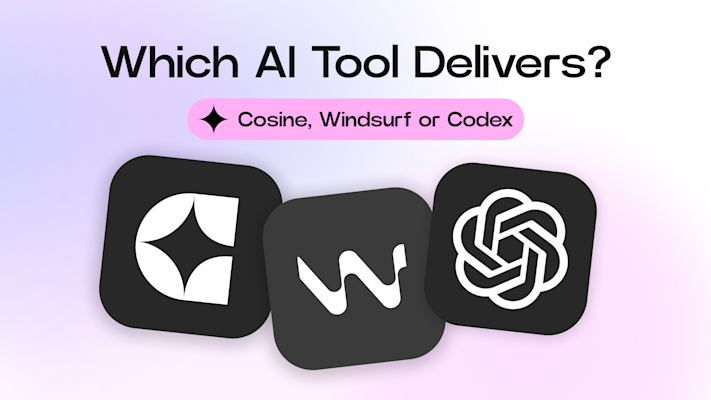In today’s fast-moving world of AI-native developer tools, sticking with a Visual Studio Code (VS Code) foundation is a strategic misstep. While others have forked or extended VS Code to stay afloat, we at Cosine took a different route. Agent Genie—our autonomous AI software engineer—runs on a faster, leaner, purpose-built platform. Why? Because retrofitting legacy IDEs, such as VS Code, limits what AI-assisted development can become. Clinging to this old model is holding our competitors back—we believe real innovation demands a clean break.
Why AI-Native Developer Tools Need a Clean Slate
Visual Studio Code (VS Code) is undeniably popular—more than just an editor, it’s become the default choice for developers worldwide. So, it might seem obvious that any AI-powered coding tool should build on that foundation. Why reinvent the wheel?
At Cosine, we saw it differently. Instead of joining the “VS Code fork” crowd, we built a purpose-built, lightweight platform for Agent Genie, our autonomous AI software engineer. We respect what VS Code has achieved—but it wasn’t designed for the AI-first future we’re building toward. Others may lean on its legacy architecture. We chose to move forward.
The Temptation (and Hidden Costs) of Forking vs Code
If you’re aiming to launch an AI developer tool fast, forking VS Code looks like an easy win. You get a familiar UI, a rich feature set (debuggers, extensions, theming), and a head start by skipping editor development. But that shortcut comes at a cost:
Bloated Codebase: Forking VS Code means inheriting years of legacy code. Every bug fix, patch, and update becomes your problem—burning valuable team bandwidth.
Desktop-First Design: Built on Electron, VS Code is optimised for local use, not cloud-native AI workflows. It’s bulky, resource-heavy, and a poor fit for scalable agent-based systems.
Legacy IDE Assumptions: Traditional IDEs assume manual, file-by-file editing. AI agents need to navigate and refactor entire codebases autonomously—something VS Code’s architecture can’t support.
Sure, you can tack on an “AI chat” panel or an autocomplete feature, but a full AI teammate needs an environment that was built with autonomous collaboration in mind—something that just doesn’t come naturally from a conventional IDE.
Heavy Legacies: “Big Name” Tools Struggle with VS Foundations
Many AI coding tools still cling to VS Code—either as forks burdened with bloated codebases or plugins confined by its APIs and UI. Both approaches hit the same limits: slower development cycles, rigid UX, and little room for innovation. Updates become maintenance marathons, and the end product often feels like “VS Code with a chat box”—familiar, but fundamentally constrained.
Worse, these tools inherit outdated assumptions. VS Code wasn’t built for AI agents that batch tasks, spin up services, or reason across entire codebases. Some try to patch the gap with remote AI backends and local UIs, forcing users to juggle IDEs, browsers, and chat apps. It’s fragmented—and far from the seamless, AI-native experience that modern development demands.
Cosine’s Choice: Building a Lean, Purpose-Built Environment
Our decision at Cosine was straightforward: we didn’t want to be bound by someone else’s architecture. Instead, we created a purpose-built environment for our autonomous AI, Agent Genie. Doing so wasn’t always easy—it meant rolling up our sleeves and developing our own code editor modules, user interface, and orchestration logic. However, the benefits quickly made all the extra work worth it.
The Future of AI Development: Unshackled from Legacy IDEs
Picture a dev environment where you don’t open files and type code—you tell an AI what you want: “Implement this feature,” “Refactor payments,” “Run performance tests.” The AI plans, edits, and validates across the codebase, all within a streamlined, interactive workspace. This is the future we envision: goal-driven, AI-powered development that surpasses today’s manual workflows.
Building that future requires abandoning old editor paradigms. It demands always-on autonomy, where the AI doesn’t wait for prompts but acts, tests, and iterates. It centres on tasks, not files—automating changes wherever needed. And it enables seamless human-AI collaboration with shared context and real-time reasoning. Legacy editors can’t support this. That’s why even tools built on VS Code are trying to break free—layering on cloud services or experimental UIs. But patching a legacy base doesn’t solve the core issue. It’s like strapping rockets to a carriage: you might lift off, but you won’t get far.
Where Others Are Stuck — and Why We’re Free to Innovate
Without naming names, here’s a general overview of what often happens to those who hitch their AI ambitions to VS Code:
Growing Maintenance Burden: They fork the editor for deeper AI integration. Initially, it’s wonderful to have full control, but soon they’re dealing with constant merges and version conflicts. Over time, this burden inflates, distracting from real AI feature development.
Limited UX Freedom: If they stick to an official extension approach, they remain at the mercy of the extension APIs. They can only go so far in modifying the UI or enabling advanced interactions. For radical improvements—like letting the AI orchestrate multi-file changes at will—these teams have to resort to elaborate workarounds.
Inconsistent “AI Experience”: Some solutions try a hybrid approach where the AI runs in a cloud environment, but the user still interacts with it through a half-baked plugin or separate chat tool. The resulting user experience can feel patchy: you have an AI with big ambitions but are forced to navigate multiple portals or modes to see what’s happening.
Slow to Evolve Beyond Simple Suggestions: Traditional IDE-based AI often evolves from glorified autocomplete to basic chat and code generation. True autonomy—like bridging unit tests, build systems, and environment configuration—takes much longer to arrive. These tools usually release new AI features in small increments because they must retrofit them into an architecture never meant for full autonomy.
Meanwhile, at cosine.sh we freely experiment with new ideas, user interface layouts, and behind-the-scenes logic. We’re not merging someone else’s code every other week or negotiating extension constraints. When we decide to improve Agent Genie, we can rewrite entire subsystems if that’s what it takes. Our velocity isn’t dragged down by a legacy foundation, and that’s a powerful advantage in such a fast-moving field.
Welcome to the Real AI Revolution
We saw early on that our autonomous AI software engineer, Agent Genie, needed a more modern environment—one optimised for real, self-directed collaboration between humans and AI. That meant taking the risk of building our own platform. Today, we’re more convinced than ever that we made the right call.
By refusing to be just another VS Code clone or fork, we’ve set ourselves apart in a crowded field. We move faster, release bolder features, and adapt to new discoveries in AI technology without being slowed down by mountains of inherited code. Our platform is lean, cloud-native, and fully aligned with how an AI agent naturally works.
If you’re ready to see what AI-native development really looks like, beyond the confines of a legacy IDE, we invite you to explore Agent Genie at cosine.sh. It’s a preview of the collaborative future that awaits all of us—one where the line between “the developer” and “the tool” begins to blur, and the entire coding process transforms into something far smarter, more creative, and more powerful than we ever could have achieved in a mere text editor.
Join us at cosine.sh and experience a new era in AI-driven software engineering.


 @PandelisZ
@PandelisZ 

